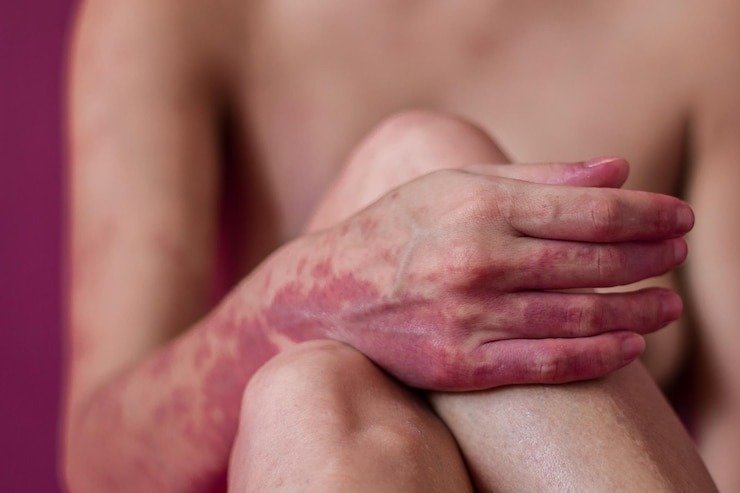Hidradenitis Suppurativa, or HS disease, is a chronic condition that is often misdiagnosed, misunderstood, and silently suffered. HS doesn’t just leave a mark; it also affects places where skin naturally rubs together, such as the groin, underarms, or under the breasts. It physically and emotionally changes people’s lives.

Tiny, sensitive pimples that may resemble acne are the condition’s innocent beginning. However, these lesions have the ability to burrow deeply, rupture suddenly, and return with greater force than a typical breakout. Some develop tunnel-like scars that physically connect beneath the skin over time, causing irreversible harm. Neither poor hygiene nor infection are the causes of HS. However, it severely disrupts day-to-day living.
HS Disease Overview
| Category | Details |
|---|---|
| Condition Name | Hidradenitis Suppurativa (HS) |
| Other Term | Acne Inversa |
| Primary Symptoms | Painful lumps, draining abscesses, tunnel formation, blackheads |
| Commonly Affected Areas | Armpits, groin, buttocks, under breasts |
| Typical Onset Age | After puberty, before age 40 |
| Risk Demographics | Women (3x more likely), individuals with obesity or family history |
| Complications | Permanent scarring, infections, impaired movement, depression |
| Treatment Approaches | Antibiotics, biologics, hormone therapy, laser treatment, surgery |
| Trusted Resource | Mayo Clinic: HS Disease |
A Disorder That Hiding in the Shadows and Folds
The fight against HS often begins in isolation for many patients. Lumps are written off as small cysts or ingrown hairs. Before an accurate diagnosis is made, symptoms gradually worsen, frequently over years. Most patients have experienced innumerable flare-ups, numerous incorrect diagnoses, and unsuccessful treatments by the time they visit a dermatologist.
HS is especially annoying when it comes to inflammatory and autoimmune diseases. Although the exact cause is still unknown, experts believe that genetics, clogged hair follicles, and hyperactive immune responses are contributing factors. Researchers are finally charting the intricate landscape of HS by contrasting it with other immune-driven conditions like Crohn’s, providing fresh perspectives on how skin can turn against itself.
Beyond Skin-Deep: HS’s Everyday Effects
Living with HS is about navigating life in anticipation of pain, not just about discomfort. Consider organizing your clothes according to the possibility that seams will aggravate sensitive areas. or balancing every social encounter with the worry about obvious odor, scarring, or drainage. There is a significant psychological toll, and for many people, the illness is like an invisible prison.
But there is growing hope. Although HS was once thought to be incurable, new discoveries are significantly changing the course of treatment. These days, medical communities support individualized treatment plans, comprehensive care teams, and earlier interventions. Slowly, the focus is shifting from survival to empowerment.
Treatment, Changed: Finally Effective Options
Today’s HS treatment options are much more comprehensive and successful than ever before thanks to the combination of cutting-edge dermatological science and a patient-centered approach.
For mild cases, topical and oral antibiotics like clindamycin and doxycycline continue to be helpful. Hormonal treatments, such as spironolactone or estrogen-containing contraceptives, can lessen the frequency of flare-ups, particularly in women, while steroid injections aid in the quick reduction of inflammation.
Biologics like Remicade (infliximab) and Humira (adalimumab) are the most remarkably effective. TNF-alpha is the primary molecule thought to be responsible for the inflammatory cascade in HS, and these immune-modulating medications target it. Biologics have significantly decreased flares for a large number of patients in a matter of weeks.
Long-term relief is also provided by laser treatments and surgical techniques like unroofing, which involves opening and draining tunnels, particularly in moderate to severe cases. In contrast to short-term solutions, these methods yield remarkably long-lasting outcomes, frequently saving patients from undergoing additional procedures.
Shattering the Silence: The Immediate Need for Public Attention in HS
HS has been marginalized in the field of dermatology for far too long; it is rarely taught in medical schools and is frequently disregarded in public discussions. But attention must be paid to its terrible physical and emotional effects. The voices of people with HS, many of whom have been silent for years due to embarrassment or fear, are starting to be heard thanks to patient advocacy and awareness campaigns.
We can drastically cut down on the years-long diagnostic delays that HS patients face by educating primary care physicians, increasing public awareness, and promoting early diagnosis. There is a chance to avoid scarring, maintain mobility, and regain confidence for each person who has not yet received a diagnosis.
